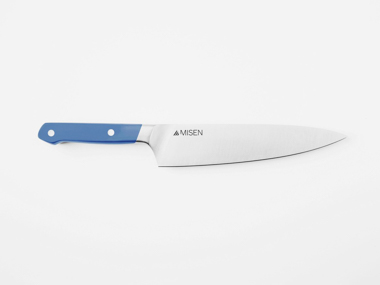Review: Misen Chef’s Knife
WIRED—October 29, 2016

AMONG ALL THE tools and gadgets that can fill a kitchen, knives are without a doubt the most personal and indispensable. Admire one in a chef’s collection and prepare for an unsolicited earful of its history, but do not expect an offer for you to try it. My own collection is modest but I’m proud of it. Among them, my favorites are a Wüsthof Classic Cook’s Knife and my Tadafusa santoku. The Wüsthof capably does everything from mincing a shallot to cutting up a chicken and the sharper blade angle of the santoku cuts through vegetables like a scalpel.
A new chef’s knife from Misen promises the best of both knives, making giant-killer claims about innovative geometry, high-grade steel, a santoku-style blade angle, and free sharpening for life. Most impressively, it brags of what it calls the “honest price†of $65, a number that’s less than half the price of the high-end knives it calls its competition.
Intrigued, I called one in to test. Misen started as a Kickstarter but is shipping its knives this fall. Days later, I had my chef’s knife, my santoku, and the Misen chef’s knife lined up next to one another on my cutting board. The most striking feature of the Misen was the side view, which looked a bit like both knives, combining the flatter belly of the santoku and both the handle and upward sweep at the tip of the chef’s knife, a sort of westernized version of a Japanese knife known as a gyuto.
I bought a bag full of groceries to chop and declared the game afoot. The differences between the three knives were immediately apparent. While the Misen most resembles a traditional chef’s knife, it doesn’t really behave like one. The Wüsthof has a large, curving ‘belly,’ a German style that encourages a rocking cutting motion with the tip of the knife planted on the board, the back end moving up and down, while the whole thing slides back and forth with each stroke. The santoku style relies more on keeping its flatter blade parallel to the cutting board, gliding forward with each downward movement.
For me, the Misen often felt most comfortable using a santoku-style stroke. It was particularly noticeable when I was working my way through something tall like a wedge of cabbage or chopping up a pile of herbs. Try a stroke that allows the Wüsthof to power through that kind of work with the Misen and it’ll feel like a flat thud every time the length of the blade hits the cutting board. That said, I felt confident that the best stroke for whatever I cut with the Misen would become apparent with use, and I’d get better with it over time.
... that’s not the way it worked out. Read the rest of the story here.